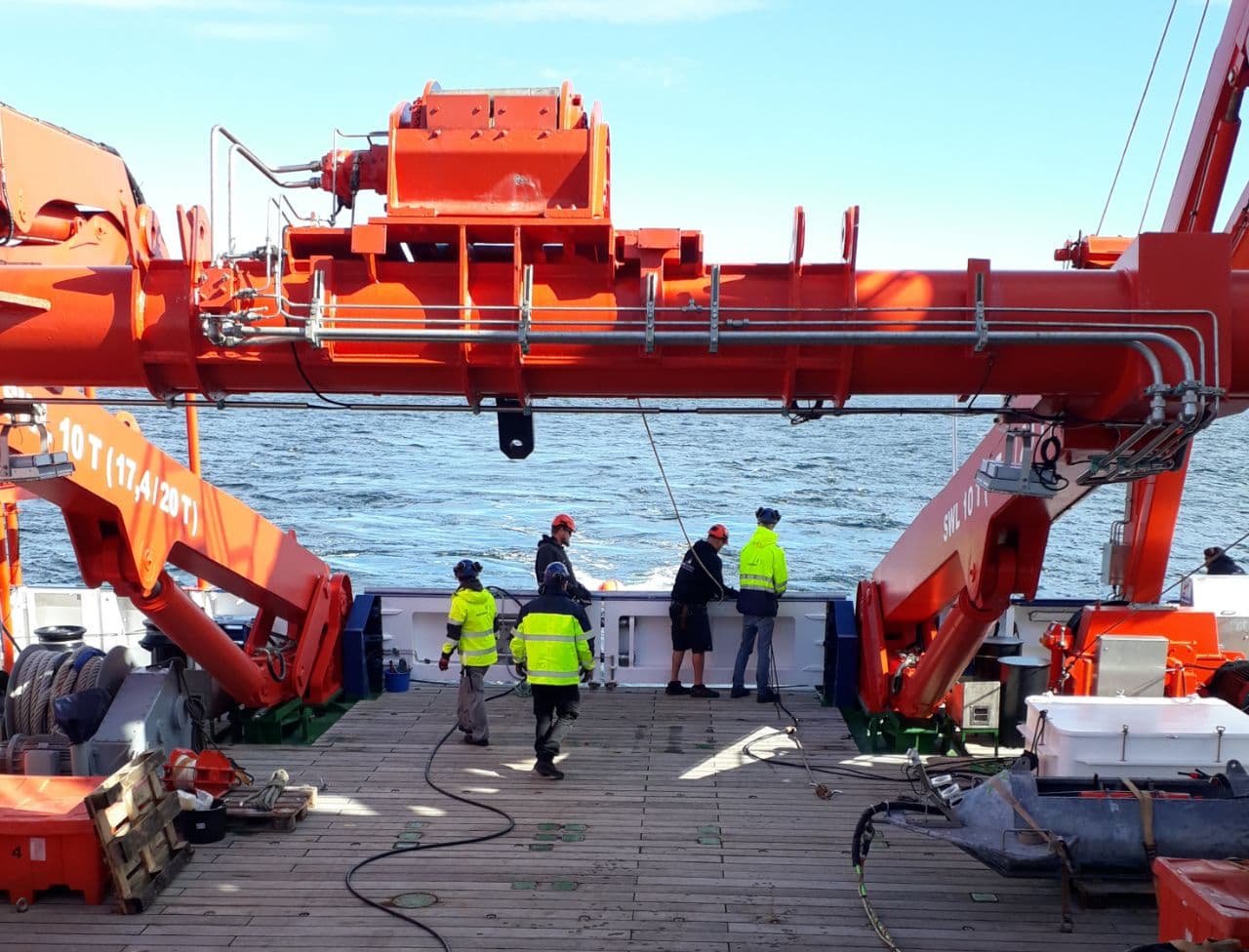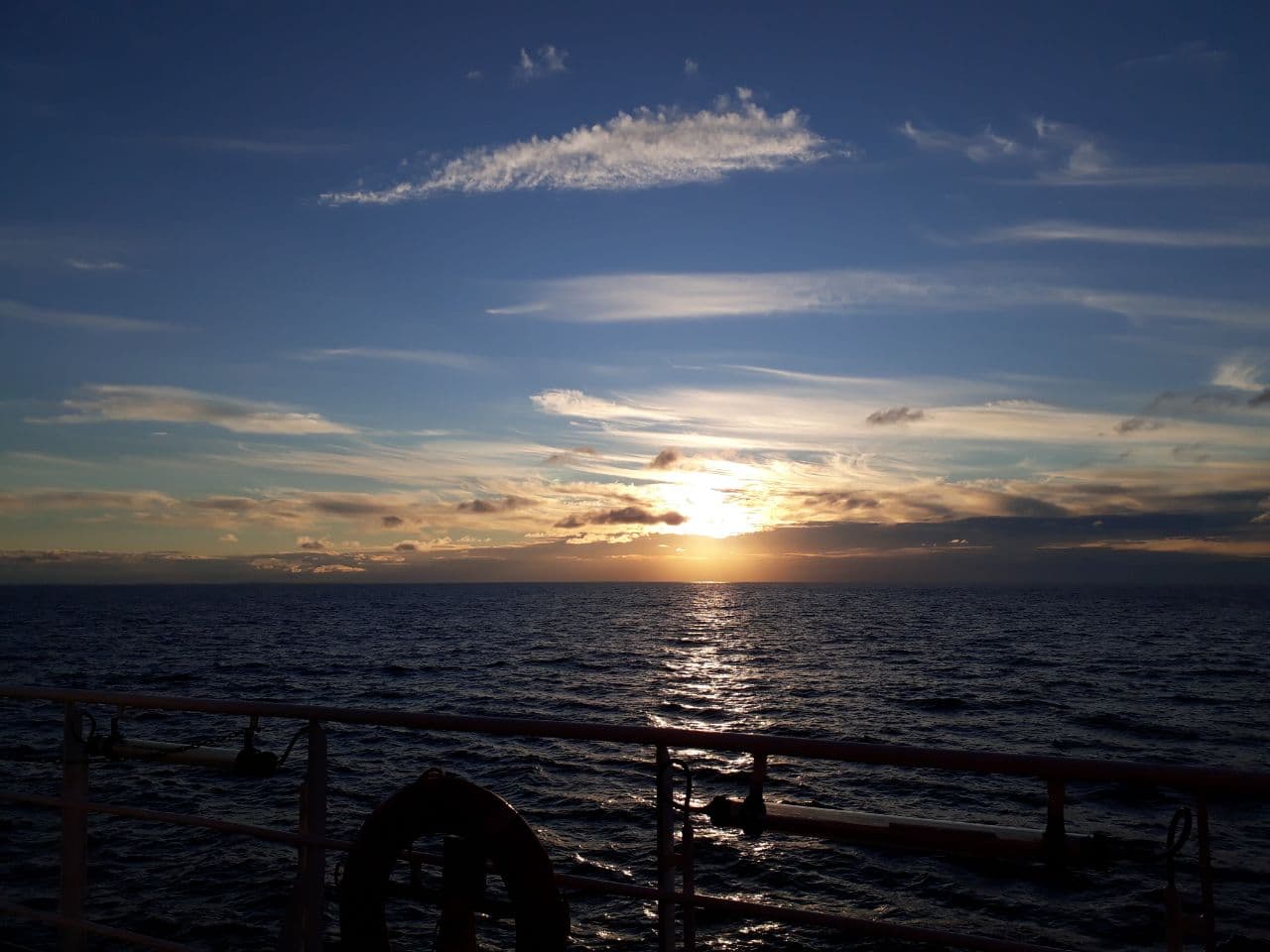Eine deutsche Version ist weiter unten zu finden.
Welcome back! Now, let me tell you who the royal adventurers (because of PRINCE, get it?) are on this journey. On this ship, we are 24 crew people and 21 scientists. We scientists are further categorizable as follows: 7 Doctoral Candidates (DC), 5 Student Assistants (HiWi), 3 Technicians (T), 2 Post-docs, 1 Chief Scientist and 3 external Marine Mammal Observers (MMO). Where, you might ask, are the senior scientists? The experienced veterans of marine science? Well, despite of our youthfulness as a group, we do have quite some miles on board research vessels and have earned our ranks among the people with responsibility-laden shoulders.
We are working together in the following methods: There is the Sediment-Coring Group, which consists of our two post-docs Irena and Monica, and Lea as a technician; the Seismics Group, which is led by Michel (DC) and Thies (T). The Electro Magnetics (EM) Group is led by Gesa (DC) and Martin (T), and is including both the work with Ocean Bottom EM (OBEM) and Controlled Source EM (CSEM). The Hydroacoustics Group, whose leadership is resting on Johanna’s (highly experienced HiWi) shoulders, completes the list. The rest of us DCs and HiWis are working in 3 different shifts throughout the day and night, helping with which ever work needs to be done during our time on duty. Our Chief Scientist, Sebastian is making sure all science is well coordinated and communicated with the captain. We will present each of the methods a little more detailed in the coming blog entries.
Then we have the 3 MMOs. They are on board, because the Gulf of St. Lawrence is a hot spot for marine mammals and our acoustic methods could potentially bother them. They make sure that, whenever we want to start our measurements, no mammals are around and if we are getting closer to each other during a survey, we are stopping our signals, so that no one gets hurt or bothered.
And, last but not least, there are the crew people, who keep everything running smoothly. There is the Captain, Ralf and his Officers, who are controlling the vessel from the bridge, the centre of communication. It is where plans and decisions are made. Everything related to the engine, the AC, compressors, water supply system, waste management and so on falls into the responsibility of the Chief Engineer Ben and his people, who are mostly working on the lower decks. Whenever there is something going on on the working deck, you will find the Bosun and a couple of Seamen operating cranes and winches, repairing, building and generally making sure, everything is running smoothly and safely on deck.

In addition, there are the System Operator Emmo and Electronics guy Lars, who are responsible for everything IT and the on-board scientific instruments. They help us make our instruments work well within the ship’s system and patiently explain whatever technical problems we might run into. We even have our own Doctor on board, though we all hope, she doesn’t get much to do during the cruise, of course. And finally, nothing would work on board, if it weren’t for our two cooks and stewardess. They are possibly the most important people on the vessel. They are preparing four warm meals a day, plus cake and coffee in the afternoon. They keep the store ready, for all the people hungry for sweets and other tasty treasures and generally keep both crew and scientists happy.
By the way, I think it is dinner time! I got to go! See you in the next entry!
Elisa

Willkommen zurück! Als erstes möchten wir vorstellen wer unsere hoheitlichen (wegen PRINCE) Abenteurer auf dieser Reise sind. An Bord sind 24 Crew-Leute und 21 Wissenschaftler*innen. Uns Wissenschaftler kann man weiter kategorieren in: 7 Promovierende (P), 5 HiWis, 3 Techniker*innen (T), 2 Post-Docs, 1 Fahrtleiter und 3 externe Walbeobachter*innen (MMO, für Marine Mammal Observer). Wo, könnte man sich fragen, sind die Senior-Scientists? Die erfahrenen Veteranen der marinen Wissenschaft? Nun, obwohl wir als Gruppe jung erscheinen mögen, haben die meisten von uns schon etliche Seemeilen auf Forschungsschiffen gemacht und gehören verdientermaßen zu den Wissenschaftlern mit von Verantwortung schweren Schultern.
Wir arbeiten hier zusammen an den folgenden Methoden, die alle zu einem späteren Zeitpunkt hier detailierter vorgestellt werden. Es gibt die Sedimentkerngruppe, die aus unseren beiden Post-Docs Irena und Monica und Lea als Technikerin besteht; die Seismik-Gruppe, die von Michel (P) und Thies (T) geleitet wird; Die EM (Elektromagnetik) Gruppe, geleitet von Gesa (P) und Martin (T), in der sowohl Ozean Boden EMs (OBEM) benutzt werden, als auch ein geschlepptes System mit kontrollierter Quelle (Controlled Source EM). Die Hydroakustik, dessen Leitung auf Johannas (sehr erfahrenen HiWi) Schultern liegt, vervollständigt das Bild. Der Rest von uns Docs und HiWis arbeitet in 3 Schichten, verteilt über Tag und Nacht, in denen wir bei Arbeiten helfen, die gerade so anfallen und Wache gehen. Unser Fahrtleiter Sebastian sorgt dabei dafür, dass alle Wissenschaft wohl koordiniert und mit dem Kapitän kommuniziert wird.
Dann haben wir 3 kanadische MMOs an Bord. Der Golf von St. Lorenz ist ein Hotspot für marine Säugetiere und unsere akustischen Messmethoden könnten sie stören. Die MMOs sorgen dafür, dass keine Meeressäuger in der Nähe sind, wenn wir unsere Messungen durchführen und dass wir sofort stoppen, wenn sie uns zu nahe kommen, so dass die Tiere nicht verletzt oder gestört werden.
Und zu guter letzt, ist da natürlich die Crew, die dafür sorgt, dass alles rund läuft. Oben von der Brücke kontrollieren der Kapitän und seine Offiziere das Schiff. Sie ist das Zentrum der Kommunikation, wo Pläne geschmiedet und Entscheidungen getroffen werden. Alles was mit der Maschine, der Klimaanlage, Kompressoren, dem Frischwassersystem, Müllverarbeitung usw. zu tun hat, fällt in die Verantwortung des Leitenden Ingenieurs Ben und seiner Leute, die meist auf den unteren Decks arbeiten. Immer, wenn auf dem Arbeitsdeck etwas los ist, findet man den Bootsmann und eine Hand voll Seemänner an Deck um die Kräne und Winden zu bedienen, zu reparieren und zu bauen und generell um einen reibungslosen Arbeitsablauf sowie die Sicherheit aller Beteiligten sicher zu stellen.

System Operator Emmo und Elektroniker Lars sind für alles an IT und die im Schiff fest installierten wissenschaftlichen Geräten verantwortlich. Sie helfen uns, dafür zu sorgen, dass unsere Geräte innerhalb des Systems an Bord gut funktionieren und erklären geduldig alle technischen Probleme, auf die wir stoßen. Wir haben sogar unsere eigene Ärztin an Bord, obwohl wir natürlich alle hoffen, dass sie auf dieser Fahrt nicht allzuviel zu tun bekommt. Und trotzdem würde an Bord nichts passieren, wenn wir nicht unsere zwei Köche und Stewardess mit hätten. Sie sind möglicherweise die wichtigsten Personen hier. Sie bereiten drei warme Mahlzeiten am Tag zu, plus Kaffee und Kuchen am Nachmittag. Sie halten den Store gefüllt für die Süßigkeiten-hungrige Horde und sorgen generell dafür, dass es Crew und Wissenschaft an nichts fehlt.
Apropos, ich glaube es ist Zeit fürs Abendbrot! Ich muss los! bis zum nächsten Mal!
Elisa
